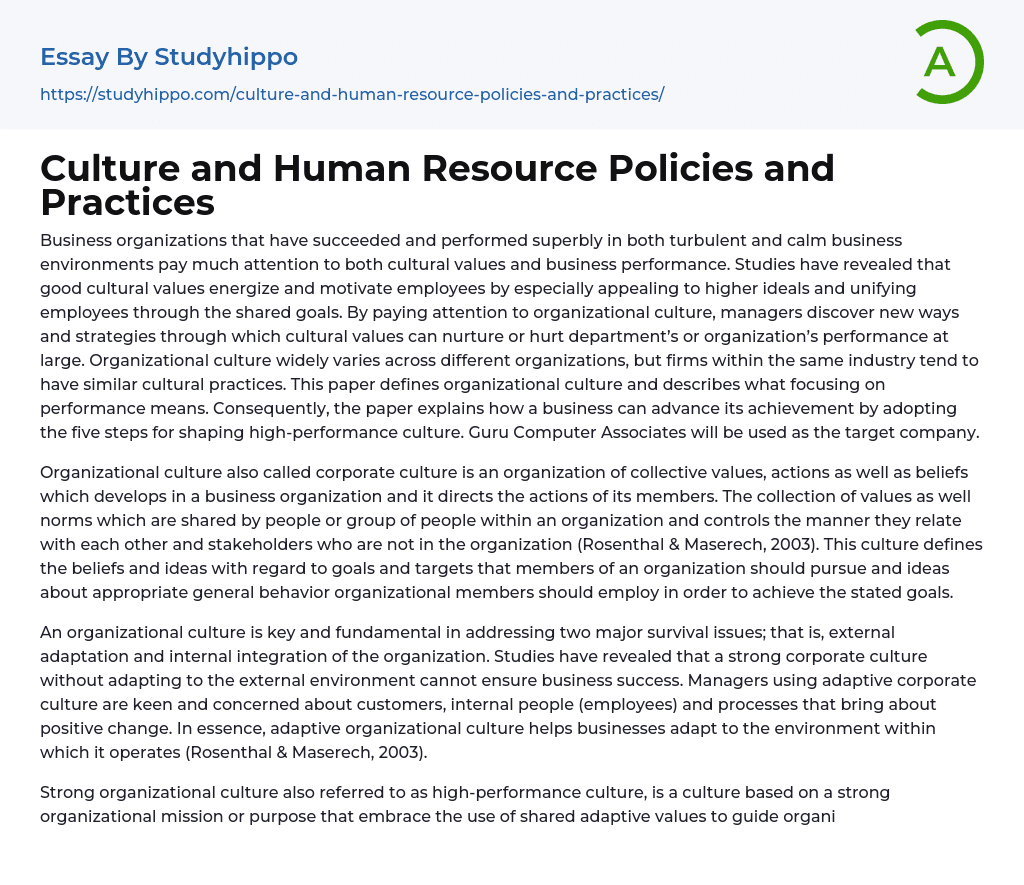

Culture and Human Resource Policies and Practices Essay Example
Business organizations that have achieved success and performed exceptionally well in both tumultuous and peaceful business environments place a great deal of importance on both cultural values and business performance. Studies have found that strong cultural values motivate employees by appealing to higher ideals and uniting them through shared goals. By focusing on organizational culture, managers can find new ways to ensure that cultural values enhance rather than hinder department or organizational performance. While organizational culture varies among different organizations, firms within the same industry tend to have similar cultural practices.
This paper defines organizational culture as the collective values, actions, and beliefs that develop within a business organization and guide its members' actions. It also discusses the concept of focusing on performance. Additionally, it outlines five steps for cultivating a high-performance culture and applies them to Guru Computer Assoc
...iates, the target company.The text highlights the importance of organizational culture and how it influences the beliefs, goals, and behavior of members within a company. It emphasizes the significance of an adaptive corporate culture that prioritizes customers, employees, and positive change to help businesses adjust to their environment. This type of culture promotes shared values, individual employee ownership, and alignment towards company objectives. It also enhances team cohesiveness and improves consistency, coordination, and control within the organization.
Managers play a crucial role in establishing a high-performance culture that focuses on value and business results to drive optimal performance. The culture within organizations has a significant impact on employee performance in all aspects ranging from major decisions to daily operations (Collins & Porras, 2005).
GCA is a global software company with 16,000 employees that has recently experienced impressive growth. Initially
starting with $500 million in assets, GCA generated net returns of $50 million last year with continued profitability as its goal. Despite falling into the quadrant where bottom-line results are given more priority over organizational values, they have still achieved substantial profits quickly. However, this lack of strong cultural values can present challenges for long-term success (Kotter & Heskett, 2007).
To establish a high-performance culture at GCA effectively there are five essential steps: clarifying and defining mission and values as a starting point; effectively communicating and translating them;Modeling these values through actions, aligning business practices accordingly, and engaging employees are essential for Guru Computer Associates (GCA) to sustain its growth and profitability in the future. It is crucial for GCA to establish a clear and compelling corporate mission that guides business decisions, fosters customer loyalty, and motivates employees to go above and beyond. Defining the mission and values is a crucial starting point in determining the overall functionality of GCA, requiring top management to internally evaluate and define authentic guiding principles. To ensure inclusivity, a cross-functional core values team can be created by gathering input from employees and managers through focus groups
providing clear examples that explain abstract concepts.It is not sufficient to simply state value statements in order to align employee behavior with the company's values. Guru Computer Associates must ensure that employees understand, witness, and experience the significance of these values by having top leadership model them. It is important for leaders to visibly demonstrate the values rather than just relying on words, as this can lead to employee resentment. Top management holds responsibility for implementing a culture based on these values in order to maintain consistency. This commitment should extend from top managers down to middle managers and all employees, as research shows that success depends on top managers who embody and promote organizational values (Kouzes & Posner, 2009).
Now, Guru Computer Associates should focus on actively engaging employees in embracing the established mission and values. Inspirational leaders should consistently communicate and actively demonstrate the organization's stated values in order to inspire ownership of the company's business culture among employees. Encouraging innovation, fostering a culture of change, building loyal teams, and demonstrating credibility are methods through which this can be achieved. By establishing shared organizational values, employee behavior will be guided and business practices will align with promises made to customers, employees, and stakeholders (Kouzes & Posner 2009). Once employees are engaged, management should monitor results and reinforce employee ownership. Employee surveys can be used by Guru Computer Associates as a tool for assessing effectiveness.
A high-performance culture that promotes individual employee ownership is crucial for business success. This culture focuses on both bottom-line results and a strong cultural foundation, which is essential for attracting and retaining talented individuals with the necessary skills to achieve objectives
and uphold core values. It encourages decision-making, stability during crises, personal connections between employees and the organization, as well as alignment around shared goals to foster community and teamwork. In conclusion, a value-driven culture plays a significant role in ensuring company success.
- American Dream essays
- Barriers To Entry essays
- Capitalism essays
- Central Bank essays
- Compensation essays
- Consumerism essays
- Economic Development essays
- Economic Growth essays
- Economic Inequality essays
- Economic System essays
- Economy essays
- Employment essays
- Export essays
- Finance essays
- Free Trade essays
- Gross Domestic Product essays
- Human Development essays
- Income Inequality essays
- Industry essays
- Inflation essays
- International Business essays
- International Trade essays
- Macroeconomics essays
- Materialism essays
- Max Weber essays
- Microeconomics essays
- Minimum Wage essays
- Monetary Policy essays
- Monopoly essays
- Pricing essays
- Profit essays
- Recession essays
- resources essays
- Taxation essays
- Trade essays
- Unemployment essays
- Warehouse essays
- World economy essays
- Bacteria essays
- Biotechnology essays
- Breeding essays
- Cell essays
- Cell Membrane essays
- Cystic Fibrosis essays
- Enzyme essays
- Human essays
- Microbiology essays
- Natural Selection essays
- Photosynthesis essays
- Plant essays



